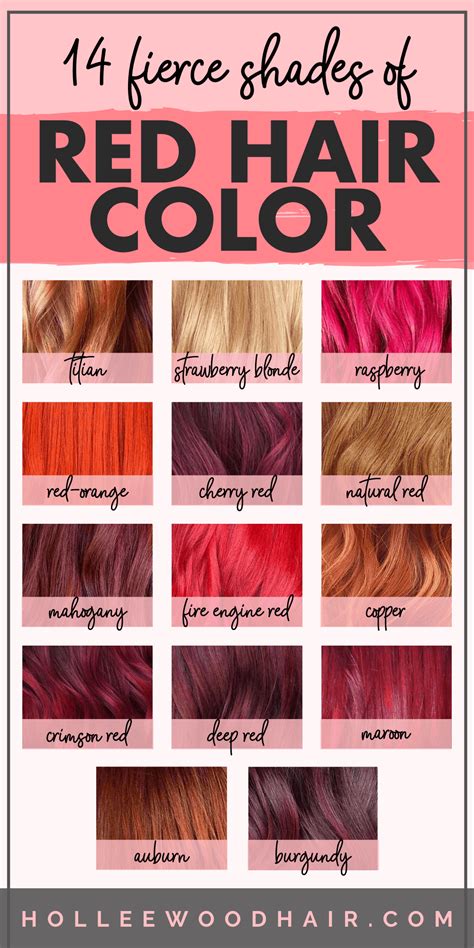The Appeal of Red Hair Color
With its vibrant hues and fiery allure, red hair commands attention and captivates hearts. According to research by the American Hair Color Council, 10% of the global population sports this striking hair color, making it one of the most popular hues among women. Its allure stems from its universal appeal, flattering most skin tones and exuding an aura of confidence and sensuality.

Types of Red Hair Shades
The kaleidoscope of red hair shades offers an array of options to suit every taste and complexion. From fiery reds to subtle coppers, each shade evokes a distinct mood and personality.
1. Auburn:
A warm, earthy shade that blends brown and red undertones, evoking the colors of autumn leaves. It suits a wide range of skin tones, particularly those with warm undertones.
2. Burgundy:
A rich, deep red that exudes elegance and sophistication. It complements darker skin tones and enhances fine hair textures, adding depth and dimension.
3. Copper:
A warm, metallic shade that resembles the reddish-orange hues of copper. It flatters fair to medium skin tones and adds a touch of warmth to cool hair.
4. Ginger:
A vibrant, spicy shade that ranges from light orange to deep gold. It embraces the fiery tones of ginger and suits fair to medium skin tones with freckles.
5. Mahogany:
A deep, reddish-brown shade that blends red and brown tones, creating a warm and sophisticated effect. It complements darker skin tones and adds a touch of mystery and allure.
6. Cherry:
A bold, bluish-red shade that captures the essence of ripe cherries. It complements cool skin tones and adds a touch of playful audacity.
7. Crimson:
A deep, bluish-red shade that evokes the color of crimson velvet. It flatters cool skin tones and exudes a sense of richness and opulence.
How to Choose the Perfect Shade of Red
Selecting the ideal shade of red hair is a personal journey that requires careful consideration of skin tone, eye color, and desired effect.
Factors to Consider:
- Skin Tone:
- Warm Skin Tones: Auburn, copper, and burgundy shades
- Cool Skin Tones: Cherry, crimson, and strawberry shades
-
Neutral Skin Tones: All shades of red
-
Eye Color:
- Blue Eyes: Copper, ginger, and ruby shades
- Brown Eyes: Burgundy, mahogany, and cherry shades
- Green Eyes: Auburn, copper, and russet shades
Potential Concerns and Solutions
Pain Points:
- Fading: Red hair dye tends to fade faster than other colors, requiring regular touch-ups.
- Damage: Chemical hair color can potentially damage hair, especially when repeated frequently.
- Skin Irritation: Some individuals may experience skin irritation or allergic reactions to hair dye.
Solutions:
- Color-Protecting Shampoo and Conditioner: Use sulfate-free products specifically designed to protect and preserve hair color.
- Deep Conditioning Treatments: Regular deep conditioning treatments nourish and repair hair, mitigating damage.
- Professional Hairdresser: Consult with a professional hairdresser to ensure proper application and minimize potential risks.
Step-by-Step Approach to Dyeing Hair Red
Materials:
– Red hair dye
– Developer
– Mixing bowl and brush
– Plastic gloves
– Old towel
– Petroleum jelly
– Hair clips
Instructions:
- Prepare Your Hair: Protect your skin by applying petroleum jelly around the hairline and ears. Section your hair using hair clips.
- Mix the Dye: In a mixing bowl, combine the hair dye and developer according to the manufacturer’s instructions.
- Apply the Dye: Using a brush, apply the dye to the roots first, working down towards the ends. Avoid getting dye on your scalp.
- Process the Dye: Allow the dye to sit for the recommended amount of time, which may vary depending on the shade and desired intensity.
- Rinse and Condition: Rinse your hair thoroughly with cool water until the water runs clear. Apply conditioner to seal in the color and nourish your hair.
Pros and Cons of Dyeing Hair Red
Pros:
- Enhances confidence and self-expression
- Complements various skin tones and eye colors
- Wide range of shades to choose from
- Can hide gray hairs effectively
Cons:
- Fades faster than other colors
- Requires regular touch-ups
- Potential for hair damage and skin irritation
- May not be suitable for all hair types or textures
Table 1: Shades of Red Hair and Their Attributes
| Shade | Description | Skin Tones | Eye Colors |
|---|---|---|---|
| Auburn | Warm, earthy red-brown | Warm | Brown, green, blue |
| Burgundy | Deep, rich red | Darker | Brown, hazel |
| Copper | Warm, metallic orange-red | Fair to medium | Blue, brown, green |
| Ginger | Vibrant, spicy orange-gold | Fair to medium | Blue, brown, green |
| Mahogany | Deep, reddish-brown | Darker | Brown, hazel, green |
| Cherry | Bold, bluish-red | Cool | Blue, gray, brown |
| Crimson | Deep, bluish-red | Cool | Blue, gray, green |
Table 2: Common Pain Points and Solutions for Red Hair Dye
| Pain Point | Solution |
|---|---|
| Fading | Color-protecting shampoo and conditioner, regular touch-ups |
| Damage | Deep conditioning treatments, professional application |
| Skin irritation | Patch test before use, consult with a professional |
Table 3: Step-by-Step Instructions for Dyeing Hair Red
| Step | Instructions |
|---|---|
| Prepare Your Hair | Protect skin, section hair |
| Mix the Dye | Combine hair dye and developer |
| Apply the Dye | Start at roots, work towards ends |
| Process the Dye | Allow dye to sit for recommended time |
| Rinse and Condition | Rinse with cool water, apply conditioner |
Table 4: Pros and Cons of Dyeing Hair Red
| Pros | Cons |
|---|---|
| Confidence boost | Fades quickly |
| Wide shade range | Requires touch-ups |
| Hides gray hairs | Potential damage |
| Self-expression | May not suit all hair types |
